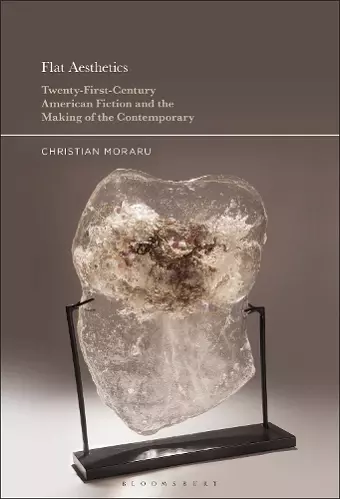Flat Aesthetics
Twenty-First-Century American Fiction and the Making of the Contemporary
Professor Christian Moraru author
Format:Hardback
Publisher:Bloomsbury Publishing PLC
Published:12th Jan '23
Currently unavailable, and unfortunately no date known when it will be back

A literary-historical study that deals chiefly with post-1990 American fictional prose and argues that David Foster Wallace's phrase, "après-garde" (the opposite of avant-garde), encapsulates an aesthetic that is applicable to much of the past thirty-odd years of American literature.
Flat Aesthetics seeks to secure a more granular and ontologically demotic handle on the contemporary in American literature. While contemporaneity can be viewed as “our” period, Christian Moraru approaches the contemporary as some-thing made by things themselves. The making of the contemporary is variously restaged by the body of fictional prose under scrutiny here. Thus, this corpus itself participates in the making of contemporaneity.
In dialogue with object-oriented ontology and various new materialisms, Moraru contends that the contemporary does not preexist objects or the novels featuring them; it is not their background but an outcome of things’ self-presentation. As objects, beings, or existents present themselves in the present, in our “now,” they foster thing-configurations that together compose the form of, and essentially make, the contemporary — the present’s cultural-material signature, as Moraru calls it.
To decipher this signature, Flat Aesthetics provides a cross-sectional reading of postmillennial American fiction. Discussed are solely post-2000 works by writers who have also established themselves over the past two decades or so, from Nicole Krauss, Michael Chabon, and Ben Lerner to Colson Whitehead and Emily St. John Mandel. Their output, Moraru claims, bears witness to the onset of a “flat” aesthetics in American letters after September 11, 2001. Organized into five parts, the books canvases objectual constellations of contemporaneity shaped by material dynamics of language, museality and display, spatiality, zombification and thing-rhetoric, and post-anthropocentric kinship.
[The] borderline utopic reimagining of the aesthetic as a fully-fledged, situationist-infused apparatus of ‘de-perverting’ objects of all sorts, pushing them outside the fraudulent logic of the transactional and into the pristine domain of their ontological truth, renders Flat Aesthetics commendable, as do its minutely conducted segments of flat reading. * Metacritic *
During the past decade, objects and material culture have come to play an increasingly prominent role in literary and critical studies. Yet, there have been hitherto no significant attempts to assess whether this trend constitutes, in American fiction, a new literary and cultural movement worthy of the name. This is the question that Christian Moraru asks and answers in the affirmative in Flat Aesthetics. He demonstrates that the thematic focus on the object has been a consistent preoccupation of several important American novelists, with remarkable results. [...] [A] user-friendly theoretical text written in a clear, solid and assertive style that itself borrows the qualities of an (intransitive) object. A book worthy of celebration and study. * Philobiblon *
Christian Moraru has been a preeminent theorist of the contemporary in literary studies. In previous studies, such as Cosmodernism, he focused on the historical movement of the contemporary in the wake of the Cold War and after 9/11 and emphasized its worldliness. In Flat Aesthetics he turns to chart its distinctive aesthetic sensibility that shifts from a center on human subjectivity to one on the mutual existence of objects, human and nonhuman, yielding a flattened aesthetics. Engaging Object-Oriented Ontology, he shows how this aesthetics runs through work by authors that have become prominent since 2000, such as Mohsin Hamid, Ben Lerner, Emily St. John Mandel, and Colson Whitehead. For Moraru, the contemporary finally is less a period than a sense of existence and an object itself. * Jeffrey Williams, Professor of English, Carnegie Mellon University, USA *
Bristling with ideas and insights, Flat Aesthetics sets in motion an exhilarating aesthetic of 'flat reading' focused on the displays, the energies, and the relations of things. Extending his previous investigations of the postmodern, Christian Moraru explores the formation of an epoch and a form that he calls the contemporary, a post-postmodern temporality in which the world of things comes into its own. * John Frow, Professor Emeritus of English, University of Sydney, Australia *
After a century or more of deep reading, the time is ripe, says Christian Moraru, for a turn to flat reading – reading that 'screens literary prose for objects,' that explores these objects in themselves and in their ensembles, and that seeks to level the playing-field on which objects interact with humans and other beings. Moraru theorizes flat aesthetics, but even more valuably he models its practice in arresting, exhilarating readings of a series of post-millennial American novels by Ben Lerner, Emily St. John Mandel, Colson Whitehead, Nicole Krauss, and others. If you are curious about what comes after postmodernism in fiction, and dissatisfied with the alternatives that have been proposed so far, then Flat Aesthetics is the place to start. * Brian McHale, Professor Emeritus of English, The Ohio State University, USA, and author of Postmodernist Fiction (1987) and The Cambridge Introduction to Postmodernism (2015) *
This effervescent book, at once a broad-based mapping of contemporary American literature and a finely calibrated weave of concepts and objects, gives us a ‘now’ opaque in its very flatness, elusive because so encompassingly near. * Wai Chee Dimock, author of Weak Planet: Literature and Assisted Survival (2020) *
ISBN: 9781501355271
Dimensions: unknown
Weight: unknown
288 pages